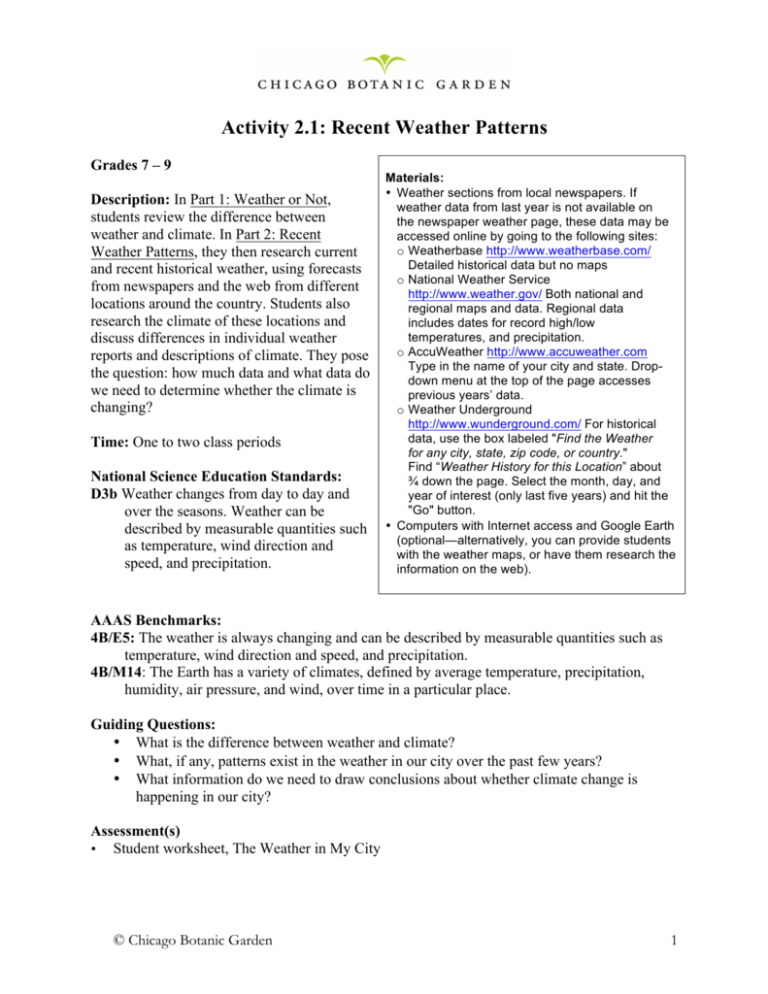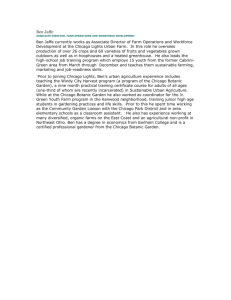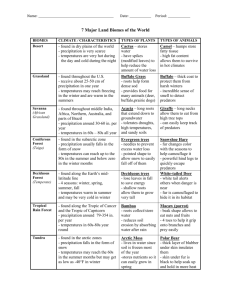Activity 2.1: Recent Weather Patterns
advertisement

Activity 2.1: Recent Weather Patterns Grades 7 – 9 Description: In Part 1: Weather or Not, students review the difference between weather and climate. In Part 2: Recent Weather Patterns, they then research current and recent historical weather, using forecasts from newspapers and the web from different locations around the country. Students also research the climate of these locations and discuss differences in individual weather reports and descriptions of climate. They pose the question: how much data and what data do we need to determine whether the climate is changing? Time: One to two class periods National Science Education Standards: D3b Weather changes from day to day and over the seasons. Weather can be described by measurable quantities such as temperature, wind direction and speed, and precipitation. Materials: • Weather sections from local newspapers. If weather data from last year is not available on the newspaper weather page, these data may be accessed online by going to the following sites: o Weatherbase http://www.weatherbase.com/ Detailed historical data but no maps o National Weather Service http://www.weather.gov/ Both national and regional maps and data. Regional data includes dates for record high/low temperatures, and precipitation. o AccuWeather http://www.accuweather.com Type in the name of your city and state. Dropdown menu at the top of the page accesses previous years’ data. o Weather Underground http://www.wunderground.com/ For historical data, use the box labeled "Find the Weather for any city, state, zip code, or country." Find “Weather History for this Location” about ¾ down the page. Select the month, day, and year of interest (only last five years) and hit the "Go" button. • Computers with Internet access and Google Earth (optional—alternatively, you can provide students with the weather maps, or have them research the information on the web). AAAS Benchmarks: 4B/E5: The weather is always changing and can be described by measurable quantities such as temperature, wind direction and speed, and precipitation. 4B/M14: The Earth has a variety of climates, defined by average temperature, precipitation, humidity, air pressure, and wind, over time in a particular place. Guiding Questions: • What is the difference between weather and climate? • What, if any, patterns exist in the weather in our city over the past few years? • What information do we need to draw conclusions about whether climate change is happening in our city? Assessment(s) • Student worksheet, The Weather in My City © Chicago Botanic Garden 1 Part 1: Weather vs. Climate (Optional, helpful if students need to review the difference between weather and climate) Procedure: 1. Open with a discussion about weather and climate. Write the terms “Weather” and “Climate” on the board. Ask students to come up and write a phrase or a word about these words. Attempt to form a class definition of weather and climate. For example: The weather is the condition of the atmosphere and how it changes over a short period. Climate is the effect of the weather over a whole area or country for a definite longer period of time. Resource: http://www.global-greenhouse-warming.com/climate-weather.html. 2. Have students work in pairs. Each pair of students will receive two cards. Students will work together to determine whether each card describes weather or climate. Note: a pair of students can have two weather cards, two climate cards or one of each. They should not assume that if one of their cards is weather, the other is climate. 3. When all groups have decided whether their cards describe weather or climate, have the students read their set of cards to the class, and explain their choice. 4. To close the activity, review the students’ working definitions of weather and climate on the board. Clarify that weather is a single event and climate is the average of multiple weather events over time. NOTE: There some debate about the difference between weather and climate, which stems from an underlying difference in perspective. Some climatologists consider climate to be an aggregate of weather events, while others consider weather to be a product of climate. The Climate System: An Overview, Trenberth, KE | Houghton, JT | Meira Filho, LG Cambridge University Press, New York, New York. 1996 Part 2: Recent Weather Patterns Pre-Activity • Have students collect temperature data for ten days before you begin this activity. Alternatively, you can have students research the past ten days of temperature data on the web, and use that to complete the rest of the activity. • Reserve the computer lab. Procedure: 1. Begin the class with a discussion of the following questions: • Is climate change really happening? How do we know it is (or is not) happening? • Where is it happening; is it happening here; how do we know? • Will we see the effects right away; will it take many years; how many? • Why do so many scientists think it is? 2. Once a variety of answers have been generated, ask “What sources of information do we have to help us answer these questions?” Before students use the Internet to search for data, © Chicago Botanic Garden 2 distribute recent weather sections of local newspapers to students. (Copies of one section will work as well.) Distribute the student handouts titled, “Weather in my City” and “Weather Resources on the Web” if you are having students research weather on the computer. 3. If necessary, review how to read a weather map with students, using one of the examples from the weather page. Make sure they understand what the different colors on the map represent, and where to find temperature information. 4. Ask the students: “What do you think is the purpose of recording temperatures every year?” 5. Next, students will use weather sections from local newspapers to try and generate a conclusion regarding whether local weather can serve as evidence of climate change. NOTE: After reading through the weather pages together, students can analyze weather from a different day, perhaps their birthday, to answer the questions on their handout. a. Have them compare daily temperatures from the weekly forecast and answer questions on their handout. Questions will include: • What trend(s) do you notice? • Does this trend indicate climate change? Explain your answer. • What other data do you think are necessary to determine if climate change is really occurring? b. Have them compare current daily temperature values to those recorded over the previous year (if present on the page). They will then answer questions on their handout. Questions include: • If the present temperature is higher than it was last year, is that evidence of climate change? • What does it mean if the temperature is lower? c. Lastly, students will compare current daily temperatures to “normal temperatures” for that time of year. They will answer questions that are similar to those above. 6. Tell students that the questions they have been asking and answering address differences between weather and climate. You may want to show them the figure “What is the difference between weather and climate” (from the Chicago Community Climate Action Toolkit, available here: http://climatechicago.fieldmuseum.org/learn) to reinforce these differences. Clarify that since climate is a long-term variable, climate change must also be a long-term variable. That is, we cannot look at one or two years of data to determine whether climate is changing. 7. Closure: Students should complete a two-question exit slip to summarize their learning from the day. The questions will be: • Is climate change happening right now in my city? Explain your answer. • Is it possible to form an accurate picture of global climate change from our analysis of one city? If yes, explain why. If no, explain what other data are needed. © Chicago Botanic Garden 3 Extension: Exploring Climate and Weather using Google Earth Pre-Activity 1. Visit the Globe site (http://www.globe.gov/explore-science/finding-globe-data) and scroll down to the Long Term Data section and download the Google Earth KML file to computers the students will be using. 2. You may want to create a shortcut on the desktop. Procedure 1. Have students open the file in Google Earth by clicking on the file, click on any recording station. 2. Then when the box opens, click on the monthly or yearly data for temperature and/or precipitation. Some of the data goes back into the 1800s. 3. Have students look at the temperature data and comment on how these historical records compare to the weather data they have looked at so far. © Chicago Botanic Garden 4 What’s the Difference between Weather and Climate? Weather = short-term changes in the atmosphere; what we experience day to day © Chicago Botanic Garden Climate = the average long-term weather pattern of a specific location; how the atmosphere behaves over many, many years 5 NAME ____________________________________ DATE ________ PERIOD ______ The Weather in My City DIRECTIONS: Use the “Weather Resources on the Web” guide and any print resources your teacher provides to answer the following questions. Current Temperatures 1. Find the past ten days of temperature data in your city. Calculate and record the ten-day average of your temperature data. °Fahrenheit. 2. Compare the temperature for each of the ten days that you collected data to the average temperature you calculated. What do you notice? 3. Look at the forecast for the upcoming week. What is the overall trend? 4. Based on your answers to questions 1 through 3, can you draw any conclusions about whether the climate is changing? Why or why not? What other information would you need? Average Temperatures 5. Find and record the mean (average) temperature for the current month 6. What is the average monthly high temperature? °F. 7. What is the average monthly low temperature? °F. °F. 8. Compare your ten-day average temperature to the monthly average high and low temperatures? What do you notice? Write down your observations. © Chicago Botanic Garden 6 Comparing temperatures over time Use the “Weather Resources on the Web” guide and any print resources your teacher provides to answer the following questions. 1. Choose one of the past ten days that you have temperature data for. Write the date here: and temperature here: 2. Using web resources, find the record high and record low for this date: Record High: Record Low: Temperatures Year Mean Temp Max. Temp Min. Temp 3. Using web resources, fill in the table on the right with the actual temperatures recorded for the past five years for the month and day that you have written above. 4. Compare the minimum, maximum, and mean temperatures in the table over the past five years. Do you see any trends? Are there any patterns in the data? How do they compare to the record high/low? 5. Based on the data you collected, and on the historical data you have researched, is it possible for weather in your city to vary considerably from day to day? From “normal” temperature values to record highs and lows? From year to year? What, if anything, does this tell you about whether or not climate change is happening in your city? Explain your answer. 6. Is it possible to form an accurate picture of global climate change from our analysis of temperature in one city? If yes, explain why. If no, explain what other data are needed. © Chicago Botanic Garden 7 Weather Resources on the Web Weather Underground http://www.wunderground.com/ To get historical weather data for your city: • Type the city and state into the box labeled "Find the Weather for any City, State or Zip code, or Country." • Once the weather forecast appears, scroll about 3/4 of the page until you see the “History & Alminac” box. • Use the drop-down boxes to choose the date that you began collecting your data. • Click “View” • Select the “Monthly” tab for monthly averages. • Select the “Daily” tab for daily actual, normal, and record temperatures. • Use the drop-down box to change dates. Weatherbase http://www.weatherbase.com/ To find average weather data for your city: • Type the city and state into the Weatherbase search box at the top of the web page. • Click on the link to your city’s weather data. • If your city is not in the search results, choose the city closest to your school. • Scroll down to the historical weather averages • To convert temperatures to Celsius, click on the “C” button in the top right-hand corner of the data box. U.S. Climate Data http://www.usclimatedata.com/ Average monthly precipitation and average monthly high/low temperatures for many cities throughout the United States. To get historical weather data for your city: • Click on your state. • Click on the city closest to your school. National Weather Service http://www.weather.gov/ This site has both national and regional maps and data. Regional data includes dates for record high/low temperatures, and precipitation. © Chicago Botanic Garden 8







